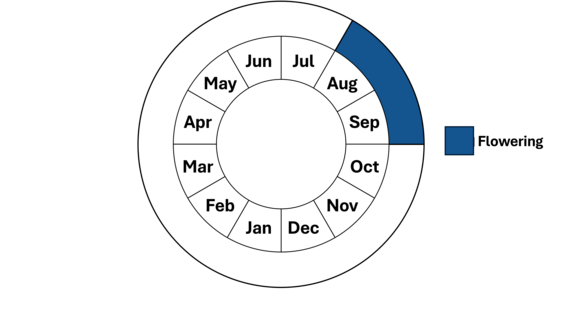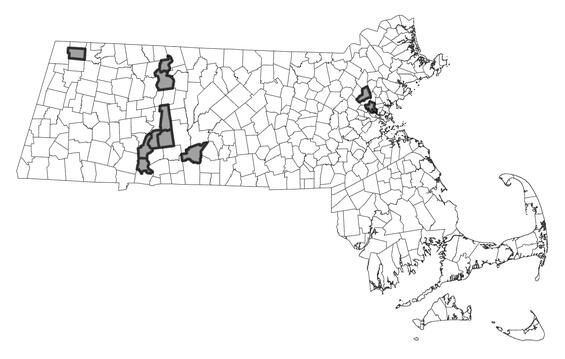- Scientific name: Desmodium cuspidatum (Muhl. ex Willd.) DC. ex G.Don
- Species of Greatest Conservation Need (MA State Wildlife Action Plan)
- Threatened (MA Endangered Species Act)
Description
Large-bracted tick-trefoil (Desmodium cuspidatum) is an erect perennial herb in the legume family (Fabaceae) that can grow up to 2 m (~6 feet). The leaves are alternate and pinnately compound. Each leaf has three acuminate, ovate-elongate leaflets, which are bright green on the upper surface and paler below. The leaflets range from 6-12 cm (2.4-4.7 in) in length. Lateral leaflets are smaller than the terminal leaflet, and have semi-persistent lanceolate stipules, which are 8 -17 mm (0.3-0.7 in) in length. The flowers are pink, 6-12 mm (0.24-0.47 in) in size, and arranged in a sparse raceme. The fruit is a loment (jointed seedpod), with three to seven articles (rhomboid-shaped segments). Each article is 9 -11 mm (0.35-0.43 in) long, and half as wide. The lower sutures of the articles are abruptly angular.
The combination of long, slender stipules (>8 mm [0.31 in]) at the base of each leaf, sharply acuminate leaflet tips, and the article characters described above differentiate large-bracted tick-trefoil from the numerous tick-trefoils known from Massachusetts, some of which can co-occur with this species. Though other species may have stipules, they are shorter and less conspicuous. The stipules of large-bracted tick-trefoil usually persist throughout the growing season.
Life cycle and behavior
This is a perennial herb. It flowers from early August through September. Its fruits are covered with tiny hooked hairs that attach to anything (fur, feathers or clothing) that brushes past them, thus spreading the fruits.

Distribution in Massachusetts
1999-2024
Based on records in the Natural Heritage Database
Population status
The large-bracted tick-trefoil is listed under the Massachusetts Endangered Species Act as Threatened. All listed species are protected from killing, collecting, possessing, or sale and from activities that would destroy habitat and thus directly or indirectly cause mortality or disrupt critical behaviors. There are currently 12 populations that have been verified since 1999, found in Berkshire, Franklin, Hampshire, Hampden, and Middlesex Counties, and is historically known from Norfolk, Suffolk, and Worcester Counties.
Distribution and abundance
Large-bracted tick-trefoil is known throughout much of eastern and central North America, from New Hampshire and Vermont, west to Ontario, Minnesota, and Nebraska, and south to the Gulf states. In New England, large-bracted tick-trefoil is critically imperiled in Connecticut and Vermont, imperiled in Massachusetts, and possibly extirpated in New Hampshire. It hasn't been assessed in Rhode Island and isn't known from Maine.

Distribution in Massachusetts
1999-2024
Based on records in the Natural Heritage Database
Habitat
Large-bracted tick-trefoil generally inhabits dry, rocky, open areas such as forest edges, rocky ridges, and embankments. It is often found in scrubby, shrub-dominated landscapes with circumneutral or alkaline bedrock. Associated species include poison ivy (Toxicodendron radicans), blackberries (Rubus spp.), multiflora rose (Rosa multiflora), and goldenrods (Solidago spp).
Healthy habitats are vital for supporting native wildlife and plants. Explore habitats and learn about conservation and restoration in Massachusetts.
Threats
Competition and over-shading from exotic invasive and aggressive native species due to natural succession and lack of natural disturbance or management is a potential threat. Many of the known large-bracted tick-trefoil habitats in Massachusetts are open disturbed sites (e.g., rights-of-way), which are highly susceptible to invasions by exotic species, and thus should be monitored periodically.
Conservation
Disturbances caused by humans can create suitable habitat for large-bracted tick-trefoil; some known habitats in Massachusetts include power line rights-of-way, and a drinking water supply service road. Appropriately timed vegetation management, through controlled burning or mechanical means, for example, may increase habitat quality and extent. All active management of rare plant populations (including invasive species removal) is subject to review under the Massachusetts Endangered Species Act and should be planned in close consultation with the MassWildlife Natural Heritage & Endangered Species Program.
References
Gleason, Henry A., and Arthur Cronquist. Manual of Vascular Plants of Northeastern United States
and Adjacent Canada, Second Edition. Bronx, NY: The New York Botanical Garden, 1991.
Haines, A. 2011. Flora Novae Angliae – a Manual for the Identification of Native and Naturalized Higher Vascular Plants of New England. New England Wildflower Society, Yale Univ. Press, New Haven, CT.
Native Plant Trust. 2014. NORM Phenology Information.
NatureServe. 2025. NatureServe Network Biodiversity Location Data accessed through NatureServe Explorer [web application]. NatureServe, Arlington, Virginia. Available https://explorer.natureserve.org/. Accessed: 5/23/2025.
Contact
| Date published: | April 15, 2025 |
|---|